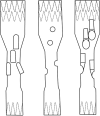Single-center initial experience with inner-branch complex EVAR in 44 patients
- PMID: 37396572
- PMCID: PMC10309562
- DOI: 10.3389/fcvm.2023.1188501
Single-center initial experience with inner-branch complex EVAR in 44 patients
Abstract
Purpose: The use of inner-branch aortic stent grafts in the treatment of complex aortic pathologies aims at broad applicability and stable bridging stent sealing compared to other endovascular technologies. The objective of this study was to evaluate the early outcomes with a single manufacturer custom-made and off-the-shelf inner-branched endograft in a mixed patient cohort.
Methods: This retrospective, monocentric study between 2019 and 2022 included 44 patients treated with inner-branched aortic stent grafts (iBEVAR) as custom-made device (CMD) or off-the-shelf device (E-nside) with at least four inner branches. The primary endpoints were technical and clinical success.
Results: Overall, 77% (n = 34) and 23% (n = 10) of the patients (mean age 77 ± 6.5 years, n = 36 male) were treated with a custom-made iBEVAR with at least four inner branches and an off-the-shelf graft, respectively. Treatment indications were thoracoabdominal pathologies in 52.2% (n = 23), complex abdominal aneurysms in 25% (n = 11), and type Ia endoleaks in 22.7% (n = 10). Preoperative spinal catheter placement was performed in 27% (n = 12) of patients. Implantation was entirely percutaneous in 75% (n = 33). Technical success was 100%. Target vessel success manifested at 99% (178/180). There was no in-hospital mortality. Permanent paraplegia developed in 6.8% (n = 3) of patients. The mean follow-up was 12 months (range 0-52 months). Three late deaths (6.8%) occurred, one related to an aortic graft infection. Kaplan-Meier estimated 1-year survival manifested at 95% and branch patency at 98% (177/180). Re-intervention was necessary for a total of six patients (13.6%).
Conclusions: Inner-branch aortic stent grafts provide a feasible option for the treatment of complex aortic pathologies, both elective (custom-made) and urgent (off-the-shelf). The technical success rate is high with acceptable short-term outcomes and moderate re-intervention rates comparable to existing platforms. Further follow-up will evaluate long-term outcomes.
Keywords: aortic stent graft; complex endovascular aortic repair; inner branches; off-the-shelf; thoracoabdominal aneurysm repair.
© 2023 Kapalla, Busch, Lutz, Nebelung, Wolk and Reeps.
Conflict of interest statement
The authors declare that the research was conducted in the absence of any commercial or financial relationships that could be construed as a potential conflict of interest.
Figures





Similar articles
-
Early outcomes of Jotec inner-branched endografts in complex endovascular aortic aneurysm repair.J Vasc Surg. 2021 Sep;74(3):871-879. doi: 10.1016/j.jvs.2021.01.067. Epub 2021 Feb 26. J Vasc Surg. 2021. PMID: 33647435
-
Inner branched complex aortic repair outcomes from a national multicenter registry using the E-xtra design platform.J Vasc Surg. 2023 Feb;77(2):338-346. doi: 10.1016/j.jvs.2022.08.034. Epub 2022 Sep 5. J Vasc Surg. 2023. PMID: 36070846
-
Systematic review and meta-analysis of published studies on endovascular repair of thoracoabdominal aortic aneurysms with the t-Branch off-the-shelf multibranched endograft.J Vasc Surg. 2020 Aug;72(2):716-725.e1. doi: 10.1016/j.jvs.2020.01.049. Epub 2020 Apr 1. J Vasc Surg. 2020. PMID: 32247700
-
Performance of Viabahn balloon-expandable stent compared with self-expandable covered stents for branched endovascular aortic repair.J Vasc Surg. 2021 Feb;73(2):410-416.e2. doi: 10.1016/j.jvs.2020.05.028. Epub 2020 May 27. J Vasc Surg. 2021. PMID: 32473341
-
["Surgeon-modified" Stent Grafts in Emergency Cases as Addition to Off-the-shelf Stent Grafts for Complex Abdominal and Thoracoabdominal Aortic Pathologies].Zentralbl Chir. 2017 Oct;142(5):496-501. doi: 10.1055/s-0043-120451. Epub 2017 Oct 27. Zentralbl Chir. 2017. PMID: 29078246 Review. German.
Cited by
-
Early Experience with Inner Branch Stent-Graft System for Endovascular Repair of Thoraco-Abdominal and Pararenal Abdominal Aortic Aneurysm.Diagnostics (Basel). 2024 Nov 21;14(23):2612. doi: 10.3390/diagnostics14232612. Diagnostics (Basel). 2024. PMID: 39682521 Free PMC article.
References
-
- Gallitto E, Faggioli G, Melissano G, Fargion A, Isernia G, Lenti M, et al. Preoperative and postoperative predictors of clinical outcome of fenestrated and branched endovascular repair for complex abdominal and thoracoabdominal aortic aneurysms in an Italian multicenter registry. J Vasc Surg. (2021) 74(6):1795–806.e6. 10.1016/j.jvs.2021.04.072 - DOI - PubMed
LinkOut - more resources
Full Text Sources

